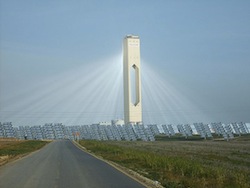World-wide renewable energy company Abengoa has announced that Solana, the world’s largest parabolic trough plant with a total installed capacity of 280 gross megawatts (MW) and also the first solar plant in the United States with thermal energy storage, has successfully passed commercial operation tests. Abengoa says this milestone marks a major accomplishment for the company and the Concentrating Solar Power (CSP) industry. The solar plant has the ability to provide electricity for nearly 70,000 average sized homes.
Solana is the first solar plant in the U.S. with a thermal energy storage system that is able to generate electricity for six hours without the concurrent use of the solar field. This is a turning point for renewable energy in the U.S., serving as a tangible demonstration that solar energy can be stored and dispatched upon demand.
 Solana, located near Gila Bend and about 70 miles southwest of Phoenix, Arizona, began construction in 2010 and, on Monday, October 7, successfully fulfilled production forecasts required to-date and testing for commercial operation. These tests included operating at the turbine’s full capacity while charging the thermal storage system, continuing to produce electricity after the sun goes down, and starting up the plant and producing six hours of electricity using only the thermal storage system. These tests successfully demonstrated the various operation modes of the plant’s operation.
Solana, located near Gila Bend and about 70 miles southwest of Phoenix, Arizona, began construction in 2010 and, on Monday, October 7, successfully fulfilled production forecasts required to-date and testing for commercial operation. These tests included operating at the turbine’s full capacity while charging the thermal storage system, continuing to produce electricity after the sun goes down, and starting up the plant and producing six hours of electricity using only the thermal storage system. These tests successfully demonstrated the various operation modes of the plant’s operation.
Abengoa’s first utility-scale solar plant in the United States employs parabolic trough technology. This technology consists of parabolic shaped mirrors mounted on structures that track the sun and concentrate the sun’s heat, later transforming water into steam and powering a conventional steam turbine. This mature technology has additional value since the heat can also be stored and used to produce clean electricity after the sun goes down or during a transitory period.
This ability to generate electricity when needed, or dispatchability, is one of the unique characteristics of concentrating solar power versus other types of renewable energy sources. The six hours of clean energy generated by Solana’s thermal storage system without the use of the solar field will satisfy Arizona’s peak electricity demands during the summer evenings and early nighttime hours. Dispatchability also eliminates intermittency issues that other renewables, such as wind and photovoltaics, contend with, providing stability to the grid and thus increasing the value of the energy generated by CSP.
Arizona Public Service (APS), the largest utility in Arizona, will purchase all of the electricity produced by the solar plant for 30 years through a power purchase agreement with Abengoa.

